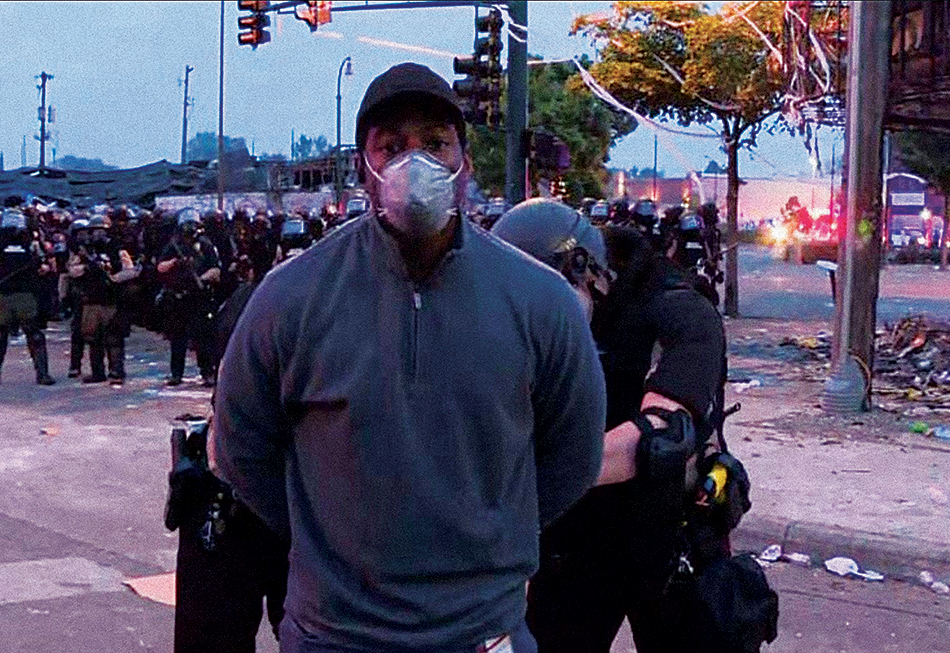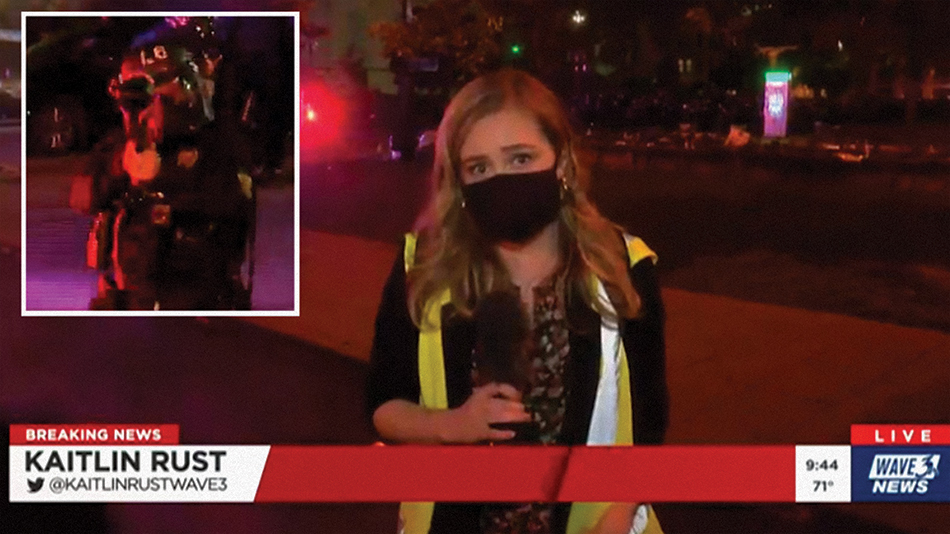Enough Is Enough
On May 27, Dymanh Chhoun of WCCO Minneapolis was tear-gassed while reporting on protests in that city; on May 29, police shot pepper bullets at Kaitlin Rust of WAVE Louisville while she was covering a protest of the shooting death of Breonna Taylor there; and on May 29, Minnesota State Patrol officers arrested CNN correspondent Omar Jimenez and his news crew in Minneapolis live on-air while on the same day, in the same city, freelance photographer Linda Tirado was hit in the eye with a tracer round.
[embed]https://twitter.com/KillerMartinis/status/1266618525600399361[/embed]
And that is only scratching the surface of the 300-plus documented incidents (at press time) that the Freedom of the Press Foundation called “freedom violations” by police and protesters against the journalists covering the nationwide protests, both peaceful and violent.
RELATED: Stories of A Lifetime for TV Reporters
Minnesota Gov. Tim Walz apologized for the CNN arrest after it went viral, and said journalists must be given space to tell their stories.
“You see incidents of [police] pushing the press [and protesters] and you say, ‘Where are we, and who are we?’ ” New York Gov. Andrew Cuomo said at one of his daily briefings. He said police must protect public safety and themselves, but that police abuses of power are also a fact. “And people are saying, ‘Enough is enough.’ ”
Journos in the Crosshairs
Multichannel Newsletter
The smarter way to stay on top of the multichannel video marketplace. Sign up below.
The Committee to Protect Journalists (CPJ) said the majority of the incidents appeared to involve police, though protesters have also appeared to target media workers, including Fox News crews chased and assaulted in Baltimore and Washington.
And journalistic organizations were looking for more than apologies.
In a letter to Walz, the Reporters Committee for Freedom of the Press said there had been improvements since that apology, but that even one assault or arrest when the police know it is a journalist is too many.

It called for the release of all arrests and interactions with police so the public could evaluate whether or not the conduct was legitimate.
And in an unusual move, the CPJ’s board sent an open letter to governors, mayors and the heads of law enforcement agencies demanding they stop police assaults on the press.
President Donald Trump has long attacked journalists as dangerous “enemies of the people,” leading to his being branded (while a presidential candidate) by the CPJ as a threat to press freedom “unknown in modern history,” as well as an ongoing threat to journalist safety.
The president was doing nothing to tamp down that inflammatory rhetoric during the protests, tweeting that the media were fake and slanted and corrupt and accusing them of inciting the violence.
[embed]https://twitter.com/realDonaldTrump/status/1267132763116838913[/embed]
Joel Simon, executive director of CPJ, suggested the problem goes deeper than an incessantly attacking chief executive, though he has likely made a bad situation worse.
In a piece for the Columbia Journalism Review, Simon said the volume and severity of the attacks on journalists during the protests have no precedent in recent memory. But he said that ascribing blame to the president’s anti-media rhetoric was too easy an answer.
“The reality is that aggressive, militarized policing across much of the country, combined with a growing number of protesters who are hostile toward traditional media, has made covering protests an increasingly dangerous assignment,” he said.
Another contributing factor has been a decline in local media and the longstanding relationships between police and familiar beat reporters who had credentials that allowed them to cross police lines, Simon said.
RELATED: A Democracy Can't Afford to Lose Its Storytellers
But the president doesn’t get off the hook.
“While Trump didn’t make covering U.S. protests dangerous, he has made the situation worse,” Simon asserted. “It is certainly possible that the president’s anti-media rhetoric has emboldened local police, who are attacking and arresting journalists at a pace not seen in recent history.”
Standing Together
The CPJ is getting together with other journalists’ organizations to send letters to police and law-enforcement agencies. They have already issued an open letter calling for police, mayors and governors to “halt the deliberate and devastating targeting of journalists in the field.”
Dorothy Tucker, president of the National Association of Black Journalists, told a Society of Professional Journalists webinar audience that there is “probably not an African-American journalist in the country who has not been the victim of racism” or had an interaction with police or knows someone who has, so they are covering a story that impacts them personally.

So while they are wearing their journalism hat, African Americans can sometimes be the target of law enforcement officers. The NABJ took an informal survey of its members and heard back from 96 journalists. Forty-two percent had been threatened by police, 10% had been arrested and 10% had been physically harmed, she said, adding, “It’s been a rough time.”
Where do journalists go from here?
Among the key takeaways from the webinar: News outlets need to focus more on putting the news in context. Reporters can’t be everywhere, which is becoming the province of “citizen journalists” with cellphones. Instead, they need to add the context and history of racial inequality, which leads to another key: More diverse newsrooms with journalists who view the struggle from a different lens, having lived the struggle and the context.
RELATED: BET’s Scott Mills on Providing a Platform
A contributing factor to the disconnect between the police and journalists doing their jobs also has to do with the cutbacks in local news, which means the police are not as familiar with the reporters covering the story. And sometimes it is not so much targeting of the press as indifference to whether someone is a reporter or not if the police are moving a skirmish line and the journalist is the impediment.
One factor that has contributed to the prominence of the debate over police treatment of journalists and protesters is that cellphones have been capturing the evidence, as was the case with the killing of George Floyd that prompted the protests.
Former Associated Press journalist Jesse Holland said the time to talk with police is now, before the next protest, and to ramp up training for both police and journalists to try and keep both sides safe.
Tucker agreed that outreach is important. She said news managers should be reaching out to law enforcement all across the country saying, “This is what is happening to our reporters.” Police officials need to talk to their officers and penalize those who violate the rights of journalists, she said.
Tucker also advised broadcasters to be careful with their language. Too frequently, she said, she heard reporters talking about “peaceful protests turning violent,” when the reality was that the peaceful protesters had gone home and the violence was coming from looters. The distinction is important, she said, and not doing so “is insulting to those protesting injustice.”
LAYING DOWN THE LAW
The Reporters Committee for Freedom of the Press said law enforcement must do these things to help stop protest coverage-related attacks on credentialed journalists:
• “Instruct your officers and staff that the arrest or physical attack of a journalist who is compliant with reasonable police orders is a clearly established First Amendment violation;
• “Take swift action to discipline any officer who is
found to have arrested or assaulted a journalist engaged in newsgathering;
• “Inform your officers that they themselves could be subject to legal liability for violating these rights;
• “Ensure that crowd-control tactics are appropriate and proportional and are designed to prevent collateral harm to journalists covering the protests;
• “Continue to exempt members of the news media from mobility restrictions, including, and especially, curfews.
• “Release all information about arrests of or physical interactions with the press to the public to allow it to evaluate the legitimacy of police conduct.” — JE
Contributing editor John Eggerton has been an editor and/or writer on media regulation, legislation and policy for over four decades, including covering the FCC, FTC, Congress, the major media trade associations, and the federal courts. In addition to Multichannel News and Broadcasting + Cable, his work has appeared in Radio World, TV Technology, TV Fax, This Week in Consumer Electronics, Variety and the Encyclopedia Britannica.

